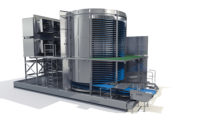Warehouse equipment aims to facilitate better storage and distribution
New warehouse equipment improves driver safety, visibility and maneuverability

courtesy of Yof Yale Materials Handling Corp.

courtesy of Baylo North America/Hyster

courtesy of Crown Equipment



The latest warehouse equipment—including lift trucks, forklifts, automated picking and autonomous vehicles—is designed to improve driver safety, visibility and maneuverability. Ergonomic features enhance operator comfort, and there is more connectivity among systems. The result is smoother storage and distribution during this key phase of the logistics chain.
Equipment updates
Many of the latest innovations in equipment like pallet trucks and forklifts focus on leveraging increased connectivity capabilities and automation to improve performance, according to Jim Gaskell, director of global technology business development, Crown Equipment Corp., New Bremen, OH. For example, the company recently added two components to its automation solutions portfolio that are designed to facilitate warehouse operations.
Crown’s Auto Positioning System enables a forklift to take the most-effective route to the next rack location. When a pick location is entered manually or shared through a linked warehouse management system (WMS), it controls the truck’s lift and travel to optimize the time required to reach and stop at the rack location. “Implementations have demonstrated that users can gain 25 percent productivity improvements compared to manually driving down the aisle and lifting the forks to the required height,” Gaskell says.
Crown’s Auto Fence operator-assist technology helps promote safety and reduce the risk of product, truck and facility damage. This is accomplished by using RFID tags to set up speed or height zones in narrow aisles, automatically slowing travel speed, stopping or limiting truck height based on the location of the truck.
Gaskell says that increased forklift connectivity helps improve operator efficiency and safety.
Navigating tight warehouse spaces requires equipment with strong maneuverability and visibility. For example, the Yale ESC030-040AD three-wheel standup lift truck is engineered for dock and drive-in/drive-through rack applications, with a turning radius of over 50 inches. “As the truck turns, the inside motor slows, stops and reverses to minimize turn radius, making stacking in limited spaces and congested loading bays easier,” says Shelley Bell, director, food and beverage industry strategy, Yale Materials Handling Corp., Greenville, NC.
Yale also has developed the MO25 multi-level order selector designed for quick first- and second-level picking of customer orders, building pallet loads of individual cases. Available with a fixed or lifting platform with independent forklift, the MO25 is suitable for cross docking and load shuttling, as well as order picking and horizontal transport.
“The low step height facilitates crossover between racks, while the foot-controlled platform allows second-level picking to help reduce operator fatigue. The anti-rollback system on ramps and gradients offers greater stability, and the adjustable performance settings allow the truck to be customized to the needs of the application and operator,” Bell says.
Ergonomic features on the Yale ESC030-040AD help provide operator comfort and combat fatigue. “Its control handle provides simultaneous control of travel and hydraulic function,” says Bell. “The Yale Smart Operator Sensing System includes no pedals, providing more useable floor space and eliminating up to 65 percent of shock and vibration transmitted to the operator.”
Toyota Material Handling USA, Columbus, IN, has introduced the Walkie Straddle Stacker (2,500-pound capacity) and Walkie Electric Pallet Jack (4,500-pound capacity) for trailer loading and unloading applications. Designed for use in small, specialized areas within a large facility, both are IP65-rated to help protect against dust and liquids, including low-pressure water streams from all directions. “The handle heads are sealed and weather-tested,” says Martin Brenneman, electric product planning, specialist-warehouse products. “The AC drive motor provides smoother acceleration and plugging, increased performance during regenerative braking and efficient power to the drive wheel. ‘No tools required’ service means less time is spent performing routine maintenance and inspections.”
Toyota also has introduced a short battery box version of its 3,000-pound capacity, three-wheel forklift. “This is a good tool for customers with tight aisles that still want to keep their operators seated, usually in situations where the operator is not on and off the truck frequently,” Brenneman notes.
Autonomous vehicles
Autonomous vehicles are becoming more prevalent in warehouses. For example, Balyo North America, Woburn, MA, offers a Robotic Lift Truck (RLT) featuring fully autonomous operation. “We take standard Hyster and Yale forklifts and pallet trucks and add Driven by Balyo Robotic software to create the RLT,” says Jeff Huerta, vice president of sales. Balyo software adapts those lift trucks to a fully autonomous solution that is customizable for the end user. The software can be changed in response to changing warehouse needs.
“Robotic lift trucks do highly repetitive tasks that can be dangerous, thus improving working conditions and freeing up workers to do value-added tasks. Robots can function 24/7 and are always checking on conditions, which improves safety and productivity,” Huerta says.
“The latest innovations in navigation systems can perform even in dynamic warehouse environments,” says Tom Kroswek, group director of product development and innovation, Ryder System, Inc., Miami. “This autonomous capability is being applied to various types of equipment, including mobile robots that can move a tote, case or pallet, as well as forklifts and clamp trucks that can move pallets, rolls of paper, or finished goods.” Ryder is evaluating the development of autonomous forklifts.
Kroswek also sees increased application of robotics to warehouse and logistics activities. These robots utilize arms and other attachments to perform each picking activity or palletize or de-palletize cases on or off a pallet. They also can be utilized for receiving and/or shipping activities.
“What is exciting about these innovations is the flexibility and application to many industries. The snack and bakery industry, which is characterized by low-weight, high-volume activity, is a good example. For instance, bread racks can be moved from the production line to delivery vehicles for loading through the use of an autonomous mobile robot, similar to the goods-to-people (GTP) robot configurations used for e-commerce,” Kroswek says.
Likewise, in the snack industry, slip-sheets of product can be moved on this type of equipment and drop deck trailers can be loaded or unloaded with industrial robots, notes Kroswek. “There is no need for a massive conveyor system installation. Instead, you can replace the functionality of the conveyor with two or three components.”
Automated picking
Many bakery and snack warehouses have been hesitant to adopt automated order picking and fulfillment for fear of damaging products, according to Brian C. Neuwirth, vice president of sales and marketing, UNEX Manufacturing, Lakewood, NJ. To ensure soft product handling, the company offers the configurable UNEX Roller Rack. “It is available with a variety of carton flow beds, which ensure smooth carton flow, keeping products at the pick point for workers. It also is available with a pallet track featuring a spring-loaded rear stop that prevents pallets from accidentally being pushed back and falling off the rack.”
Many innovations in robotic order picking are now emerging as game-changers, according to Marvin Logan, director of consulting, Bastian Solutions, Indianapolis. “Goods-to-people (GTP) has taken off in recent years. This is where robot shuttles bring product to the pickers, eliminating human travel time usually related to order picking. This travel time can account for 50 percent of the total time required to pick goods, making GTP an efficient solution for order fulfillment.”
Looking for a reprint of this article?
From high-res PDFs to custom plaques, order your copy today!








